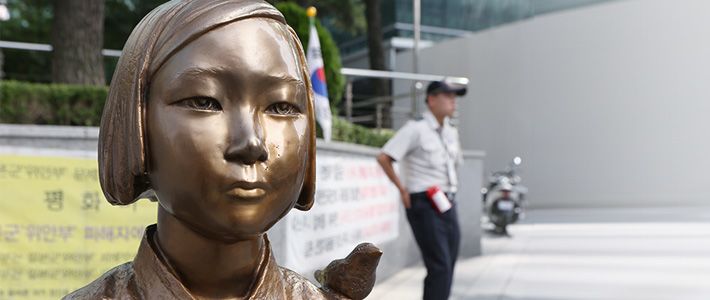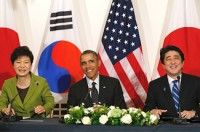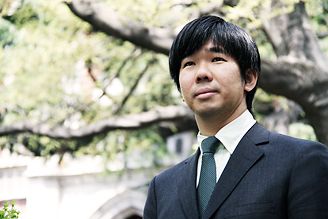
Japan’s Foreign Policy Options Following Asahi’s “Comfort Women” Retraction
Politics- English
- 日本語
- 简体字
- 繁體字
- Français
- Español
- العربية
- Русский
Japan’s relations with South Korea today are haunted by the past, having become severely strained over the “history” issue and competing territorial claims. Perhaps the first place to start in seeking a rapprochement, in my opinion, would be the dispute involving wartime “comfort women.” This is not because this is an easy issue to resolve but because all other disputes are far too complicated. Compared to the situation at the beginning of this year, moreover, I have seen what appear to be nascent signs of improvement.
American Exasperation
The situation appeared hopeless in January. Prime Minister Abe Shinzō had made a surprise visit to Yasukuni Shrine on December 26, 2013, and popular support for a revision of the 1993 Kōno Statement—released by then Chief Cabinet Secretary Kōno Yōhei acknowledging the Japanese Army’s involvement in the operation of “comfort stations” during World War II—gained momentum. The day after the prime minister’s Yasukuni visit, the Japan Restoration Party announced it would launch a signature drive for the retraction of the Kōno Statement early in the new year, and the January 1, 2014, edition of the conservative Sankei Shimbun carried an article blasting the statement for deceiving the public.
These developments clearly exasperated the United States, which had hoped to work with both Japan and South Korea as partners in efforts to deal with its biggest concern in East Asia: the rise of China. The last thing Washington wanted was a further complication of the already entangled Tokyo-Seoul relationship over the history issue.
On March 12 and 13, Administrative Vice-Minister for Foreign Affairs Saiki Akitaka visited South Korea, and on March 14 Prime Minister Abe told the House of Councillors Budget Committee that his cabinet had no intention of revising the Kōno Statement, adding he “stood by the consistent position of the Government of Japan” and expressing “heartfelt sympathy and sincere apologies to the women who suffered immeasurable pain and hardships.”This was the same comment he made in a telephone conversation with President George W. Bush in 2007 in the face of fierce criticism in the United States over remarks denying that women were forced into service. During the same Budget Committee meeting, Chief Cabinet Secretary Suga Yoshihide noted that an investigation into the process by which the Kōno Statement was drafted would be necessary, setting the direction for developments that would follow.
▼Further reading
|
The concessionary reiteration of “heartfelt sympathy and sincere apologies” had immediate diplomatic repercussions, enabling a summit between Abe, South Korean President Park Geun-hye, and US President Barack Obama, who mediated the trilateral meeting on the sidelines of the Nuclear Security Summit in The Hague on March 25. It might be fair to say that Obama’s April trip to Japan and South Korea would not have been possible without this first step. The trip also moved the reconciliation process to the next stage, although Obama’s remarks in Seoul, describing the comfort women issue as a “terrible and egregious” violation of human rights, threatened to reignite bilateral tensions.
Cool Overseas Reaction
That next stage was a reexamination of the Kōno Statement’s drafting process, as promised by Chief Cabinet Secretary Suga. The review produced a lengthy document titled, “Details of Exchanges between Japan and the Republic of Korea (ROK) regarding the Comfort Women Issue” on June 20.
The international reaction to the report was cool at best. The South Korean Ministry of Foreign Affairs immediately expressed “deep regret,” noting that the review by the Japanese government “runs counter to its pledge to uphold the Statement” and that the “Kōno Statement is a document which the Japanese government drew up based on its own investigation and judgment. . . . At repeated requests from the Japanese side, the ROK government merely presented its views informally.”
In a June 22 editorial titled “Japan’s Historical Blinders,” the New York Times blasted the report for exacerbating tensions with Seoul, and I have been informed by my American friends that the reaction in Washington, including the White House and State Department, was generally along these lines. I submitted an op-ed to the Times disagreeing with its editorial, but it was rejected. (Incidentally, an article containing the gist of my arguments will be included in an upcoming special issue of the East Asia Forum, published by the Australian National University.)
Broader Domestic Support for the Statement
In Tokyo, despite fears abroad that the report would strengthen the position of Japan’s “deniers,” it had the unexpected effect of enhancing domestic support for the Kōno Statement—both among its proponents and skeptics. The review showed that the statement was not meant to imply that women were physically forced into servitude (that is, grabbed by the neck and rounded up in trucks as if being abducted). It also revealed that the Korean officials who offered their comments were conscientious diplomats simply doing their jobs. The Japanese drafters took full responsibility for the final wording, moreover, and were under no impression that the Korean input had altered the statement’s essence.
Kōno Yōhei himself immediately issued a statement verifying the report’s findings, saying that there was nothing for him to “add or subtract” and that everything in the report was correct.(*1) The Kōno Statement thus gained new life as a result of the review.
The Asahi Retraction
The comfort women debate took a new turn with the surprising disclosure by the Asahi Shimbun in a four-page spread on August 5 that it was retracting articles based on the 1982 testimony of Yoshida Seiji—who claimed he had coerced women on the island of Jeju into service—because it concluded that his statements had been fabricated.
Yoshida’s testimony had been the prime initial source of the comfort women dispute and helped create the image of Japanese soldiers hunting down women, as described in Ienaga Saburō’s 1985 Sensō sekinin (War Responsibility), the 1996 “Coomaraswamy Report” by the UN Commission on Human Rights, and the 2007 US House of Representatives Resolution 121.
Asahi’s denial of the Yoshida testimonies prompted Takaichi Sanae, then chair of the Liberal Democratic Party’s Policy Research Council, to demand that Chief Cabinet Secretary Suga issue a new statement on comfort women, which Suga promptly rejected.(*2)
Reconciling with Survivors
Now is the time, in my opinion, for the Abe cabinet to make the necessary diplomatic overtures to begin making progress on this issue, which has had undesirable consequences for Japan’s relations not only with South Korea but also with the rest of the international community. There are a number of things it can do, as I have been proposing on various occasions since Abe’s first term in 2007.
▼Further reading
|
The first is to seek reconciliation with the approximately 50 former South Korean comfort women who are still alive. Ultimately, only they can say with absolute authority whether or not the Japanese gestures are satisfactory. This is the only way to resolve this issue once and for all and to prevent it from becoming a political impediment for Japan.
In recent discussions with Korean experts, I am often struck by the unequivocal need for expressions of remorse that truly reach the hearts of the surviving women—words that convey the sentiments expressed in Prime Minister Abe’s March 14 Diet statement. Another essential element is concrete action; while the Asian Women’s Fund to provide compensation to former comfort women was established with donations from the private sector, a new scheme should be set up with funding primarily from the government. These two measures must be initiated by the Abe cabinet, but their effectiveness in achieving reconciliation also hinges on the full cooperation of the South Korean government.
Monuments to Bilateral Tensions
The second key consideration in resolving the dispute is to avert a situation that would make it impossible to reach a settlement. Should reconciliation with the surviving comfort women fail, Japan would need to negotiate with the Korean Council for the Women Drafted for Military Sexual Slavery by Japan, or Chongdaehyop, a nongovernmental organization that sees the comfort women issue as symbolic of the evils perpetuated by the Imperial Japanese forces during its colonization of the Korean Peninsula and refuses to accept reconciliation unless Japan takes legal responsibility and recognizes its crimes. Chongdaehyop is an extremist group that attempted to turn the 61 women who accepted the apology from the Asian Women’s Fund into social outcasts, asserting that they had betrayed South Korean interests. Were Chongdaehyop to become the chief spokespersons for the comfort women, the issue would likely never be resolved.
The third factor in advancing a settlement is the issue of the statues that are now being built in the United States and elsewhere in memory of the comfort women. This is a complicated issue that may be more about domestic politics than Japan–South Korean relations; it is worth noting, though, that the chief proponents of these memorials are ethnic Koreans living abroad, and they now appear to be coordinating their efforts more closely with ethnic Chinese. The only way to prevent Japanese–South Korean tensions from becoming permanent fixtures in international society is for Seoul and Tokyo to reach an amicable reconciliation.
Coercion Is a Nonissue
The fourth factor is what to make of the lack of evidence for the forcible abduction of comfort women, as made clear by Asahi’s retraction of articles based on the Yoshida testimonies. Whether the women were actually coerced or coaxed is not an issue for the rest of the world. US public opinion, for one, is focused on how Americans would feel if their daughters were in the comfort women’s shoes. It makes no differences to them whether the women were lured by lies or herded into trucks.
The retraction by Asahi thus has had virtually no impact on global opinion. There has been little reaction from experts either, since the veracity of Yoshida’s testimony of forced recruitment had long been in doubt, based on research published in 1997 by scholars Hata Ikuhiko and Yoshimi Yoshiaki.
Inasmuch as the Asahi retraction is based on information that is nearly two decades old, it is unlikely to make much of an impact on the comfort women issue per se. This, too, is more of a domestic issue concerning Japan’s media coverage, and it will not affect the course of the bilateral dispute.
The only way to resolve the issue, as I have noted above, is to achieve reconciliation with the approximately 50 survivors. This will require efforts by both governments, and there is little time left.
(Banner photo: A statue of a girl erected as a memorial for comfort women in front of the Japanese embassy in Seoul. © Jiji.)
Abe Shinzō Asahi Shimbun comfort women Park Geun-hye Kono Statement Abe cabinet reexamination Yoshida Seiji Japan–South Korea relations history issue
 Japan, Korea Participate in First Summit Since 2012
Japan, Korea Participate in First Summit Since 2012 Japan and South Korea: Time for a Reboot
Japan and South Korea: Time for a Reboot